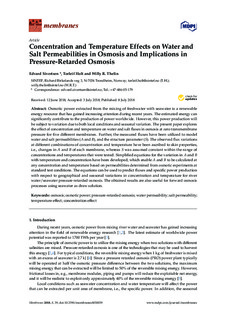Concentration and Temperature Effects on Water and Salt Permeabilities in Osmosis and Implications in Pressure-Retarded Osmosis
Journal article, Peer reviewed
Published version
Date
2018Metadata
Show full item recordCollections
- Publikasjoner fra CRIStin - SINTEF AS [5852]
- SINTEF Community [2270]
- SINTEF Industri [1571]
Original version
10.3390/membranes8030039Abstract
Osmotic power extracted from the mixing of freshwater with seawater is a renewable energy resource that has gained increasing attention during recent years. The estimated energy can significantly contribute to the production of power worldwide. However, this power production will be subject to variation due to both local conditions and seasonal variation. The present paper explores the effect of concentration and temperature on water and salt fluxes in osmosis at zero transmembrane pressure for five different membranes. Further, the measured fluxes have been utilized to model water and salt permeabilities (A and B), and the structure parameter (S). The observed flux variations at different combinations of concentration and temperature have been ascribed to skin properties, i.e., changes in A and B of each membrane, whereas S was assumed constant within the range of concentrations and temperatures that were tested. Simplified equations for the variation in A and B with temperature and concentration have been developed, which enable A and B to be calculated at any concentration and temperature based on permeabilities determined from osmotic experiments at standard test conditions. The equations can be used to predict fluxes and specific power production with respect to geographical and seasonal variations in concentration and temperature for river water/seawater pressure-retarded osmosis. The obtained results are also useful for forward osmosis processes using seawater as draw solution

